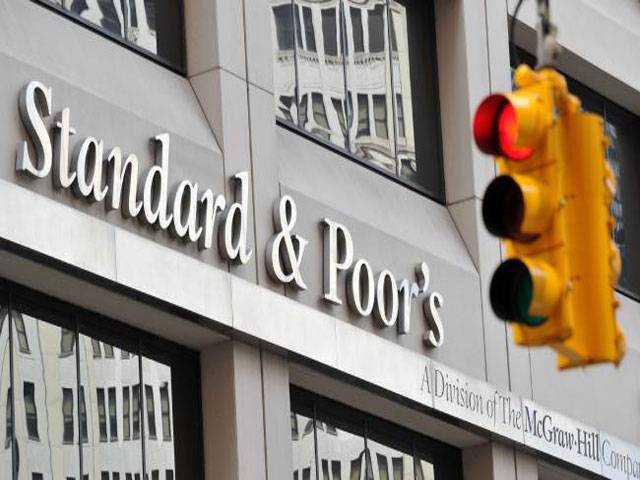ISLAMABAD - Standard and Poor's (S&P) Global Ratings, a global rating agency, on Monday affirmed Pakistan's 'B' long-term and short-term sovereign credit rating.
“The outlook for the long-term ratings remains stable,” the S&P stated in its latest report. The stable outlook reflects the S&P expectations that Pakistan's external and fiscal metrics will not worsen materially from their current levels. “We believe the country's economic prospects remain favourable,” it stated. S&P further expected Pakistan's GDP to grow at an average of 5.7 percent in the period 2017-2020. Meanwhile, the government of Pakistan welcomed the annual rating report by S&P as a manifestation of soundness of economic policies. “Affirmation of Pakistan's better economic prospects, higher and inclusive GDP growth in coming years with stable economic outlook reflects on the economic management of the government of Pakistan” the Ministry of Finance spokesperson said.
“We may raise our ratings on Pakistan if the country's security environment settles to an extent that economic growth continues to trend higher, strengthening the country's fiscal and external positions. Conversely, we may lower our ratings if the current infrastructure investments do not yield any positive impact on macroeconomic stability. Indications of this would include GDP growth below our forecast, or external or fiscal imbalances higher than what we expected,” the S&P stated.
The S&P has revised downward our expectation of Pakistan's external performance due particularly to an expected surge in imports stemming from substantial infrastructure-related CPEC projects in the next two years. “In addition, we anticipate that further fiscal consolidation might be challenging, owing to lower-than-expected performance at the regional government level and the upcoming elections in June 2018. At the same time, we expect external imbalances to abate after the peak of CPEC investments,” the report said.
The ratings on Pakistan remain constrained by a narrow tax base and domestic and external security risks, which continue to be high. These factors weaken the government's effectiveness and weigh on the business climate. The S&P believed the 2018 general elections will have a limited impact on the policy environment. The very low income level remains a rating weakness. “We expect the 2018 general elections to have a limited impact on the macroeconomic environment,” it added.
Pakistan's GDP per capita is estimated at $1,500 in 2017, which is in the bottom 10 percent of all sovereigns rated by S&P Global Ratings. It has also revised upward our forecast of annual GDP growth to average 5.7 percent over 2017-2020. Nevertheless, Pakistan's per capita GDP growth is around 3 percent, in line with peers' at this income level, due to a fast-growing population. Our stronger growth projection mainly reflects the large-scale investments associated with the China-Pakistan Economic Corridor (CPEC). In April 2015, Pakistan and China signed more than 50 agreements totalling $60 billion of Chinese investments over the coming decade in Pakistan.
Pakistan suffers from domestic security challenges and long-lasting hostility with neighbouring India and Afghanistan. Inadequate infrastructure, mainly in transportation and energy, acts as further bottlenecks to foreign direct investments. The PML-N government has improved the security situation. It has also been closing infrastructure shortfalls through energy sector reforms, such as changes to tariff structures that have cut energy subsidies and reduction in power outages for industrial consumers. However, we believe there is much more to be done before we can see considerable uplift to the business climate.
Infrastructure investments lead to higher-than-expected external imbalances. The S&P also project weaker general government fiscal balances, owing to lower-than-expected performance at the regional government level and the upcoming elections in June 2018. We forecast net general government debt to slightly exceed 60 and of GDP in fiscal 2018. Pakistan's interest-servicing burden has reduced but remains extremely heavy as a share of fiscal revenue.
Pakistan's current account deficit widened to 4 and of GDP in the fiscal year ended June 2017 from 1.7 and the year before. This was mainly caused by a large trade deficit on the back of higher imports (17pc increase) without a matching performance by exports. Imports of fuel, machinery, and food items increased sharply due to robust domestic demand and ongoing power and infrastructure development activities related to CPEC. Remittances, an anchor of Pakistan's current account, stabilised in 2017 after years of healthy growth. This was due to a slowdown in the Gulf countries. That said, current transfers held up despite a 6.5 percent overall decline in the South Asia region.
The current account deficit will remain high in the next two years, with narrow net external debt hovering at about 150 percent of current account receipts, which is substantially higher than we expected previously. Although CPEC is a decade-long initiative, the bulk of the capital goods imports happen in the first three years. Hence, we expect the external deterioration to be temporary and will likely reverse from mid 2019 onward.
“Pakistan's fiscal profile has remained below our previous expectations. The change in general government debt stood at 5.4 percent of GDP in fiscal 2017. The main reasons for the higher-than-expected fiscal deficit were the increased spending of the provincial governments and the still-inefficient tax collection system. In addition, fiscal relief measures and tax incentives to support investment, exports, and domestic production also amplified the deficit. Although the government has reiterated its commitment to long-term fiscal consolidation, our forecast assumes a general government deficit of 6 percent of GDP for fiscal 2018, taking into account the upcoming elections,” it stated. This compared with a 4.1 percent deficit assumed by the authorities.
The S&P forecasted the ratio of net general government debt to GDP to increase to just above 60 percent in fiscal 2018. “Our assessment of Pakistan's debt burden is constrained by its enormously high level of interest expense to fiscal revenue. Interest expense consumes nearly a third of government revenue, partly a function of its narrow tax base. Pakistan's ratio of tax revenue to GDP remains one of the lowest among sovereigns that we rate,” the report stated.






